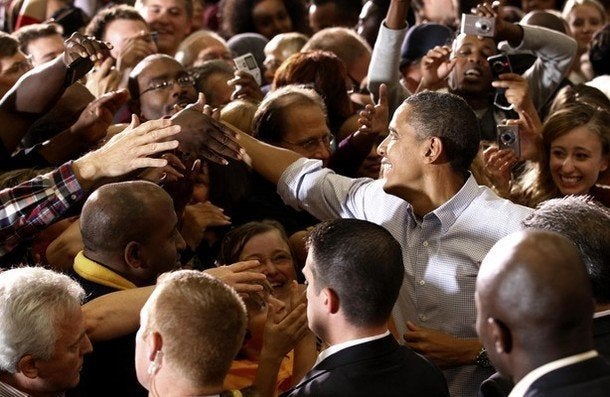
Nate Silver, political statistician extraordinaire, has posted an analysis of early voting partisan registration statistics, in states that report them, drawing upon a story by Molly Ball in Politco. I'll cut to the chase. Here is what Nate concludes in his analysis, which is largely consistent with Molly's headline that early voting shows "Signs of GOP Passion":
So, the various estimates of early voting data each show an edge for Republicans: their voters have been slightly more inclined that Democrats in most states thus far. Under the most favorable set of assumptions for them, their advantage is around 9 points; by the least favorable set of assumptions, it is more like a 4-point edge.
Unfortunately, Nate's analysis is fatally flawed. Molly provides the key damning evidence against Nate -- and against her own headline.
California provides an illustrative example of the complexities of interpreting early returns. According to data gathered by the Atlas Project, a private Democratic consulting firm, 43 percent of California early voters have been Democrats, while 39 percent have been Republicans. Considering the Democrats' current 44-31 registration advantage in the state, the GOP appears to be outpacing its share of the electorate, while Democrats appear to be staying home. Then again, in the 2006 early vote -- a great year for Democratic candidates -- each party drew 41 percent, a performance that was below Democratic registration and well above the Republican share.
In other words, in 2006 Democrats and Republicans were even in party registration among California's early voters. In 2010, so far registered Democrats have a plus 4 advantage over Republicans. Democrats are doing better among California early voters than in 2006 -- the year that Democrats took control of both chambers of Congress -- and this is evidence for GOP passion? For Nate, the answer is, "Yes." He reaches the conclusion that because there are far more registered Democrats in the state than Republicans, the 2010 early voting percentages will translate into a plus 9 advantage for Republicans over their baseline support in the state when the vote is tallied.
To make a valid comparison, one needs to compare apples to apples. In this instance, we need to know the partisan breakdown of early voters in previous elections so that we have a good baseline for comparison. California is the only state that Molly makes this comparison, and Nate doesn't have a single case. They both proceed to compare a state's partisan registration to the partisan registration of early voters. There are any number of reasons why these two are not the same. Here are the three most damning errors in Nate's and Molly's analyses:
- Nate and Molly assume that overall voter turnout rates are typically similar for registered Democrats and registered Republicans. This is not the case. Registered Republicans tend to vote at higher rates. It is invalid to compare early voters to all registered voters in the current election.
- Nate and Molly assume that early voters are the same as Election Day voters, when there is plenty of evidence that they are not - except for the all-mail ballot states. Nate's biggest pro-Republican state, Pennsylvania, exposes this poor assumption. There is a simple explanation for the apparent doom that Nate spells for Joe Sestak. Pennsylvania has a relatively small number of returned ballots because the state requires an excuse to vote an absentee ballot. There is a mountain of survey evidence that excuse-required absentee voters tend to be Republican (think: retirement homes and traveling businessmen). A valid comparison is early voters in the current election to early voters in a previous election, not registration in the current election -- or exit polls in 2008, which Nate also analyzes.
- More generally, the first early voting numbers a state reports tend to heavily composed of absentee mail ballots, like those in Pennsylvania. As Election Day draws closer, the numbers have tended to shift in a Democratic direction. A more valid comparison is early voters now to early voters at a similar point in time in a previous election.
In the past, Republicans tended to vote early. That changed in 2008. And here is the final difficulty in these forecasts, no one knows if 2010 will be a continuation of 2008 or a reversion to previous elections. At this point, the best prognosticating that I can say is that these early voting numbers are neither as good for Democrats as they were in 2008 nor are they as doom and gloom as Gallup and Rasmussen polling suggests. There are also state variations, too, such as Republicans performing very well in Florida. By and large, I believe that the early voting numbers generally confirm the polling showing key competitive U.S. Senate and governor races.
Nate comes to a somewhat similar conclusion, although Nate over-estimates the national Republican "enthusiasm gap" from the early voting due to his misunderstanding of the limitations of the election data he analyzes. I admit it is easy to snipe at someone's work. The analysis I outline in the bullet points above is possible for a couple of states where data are available, though I am uncertain of the value of such analysis because there is no good baseline election. As Molly quoted me, "We are in uncharted territory."
UPDATE: Nate responds, or I guess I should say Mr. Silver since he formally calls me Mr. McDonald (we've chatted via e-mail, so why so serious? Perhaps the New York Times editors force seriousness upon you). Mr. Silver and I apparently agree that we are in "uncharted territory" and that his first analysis deserved the extra skepticism I heaped on it.